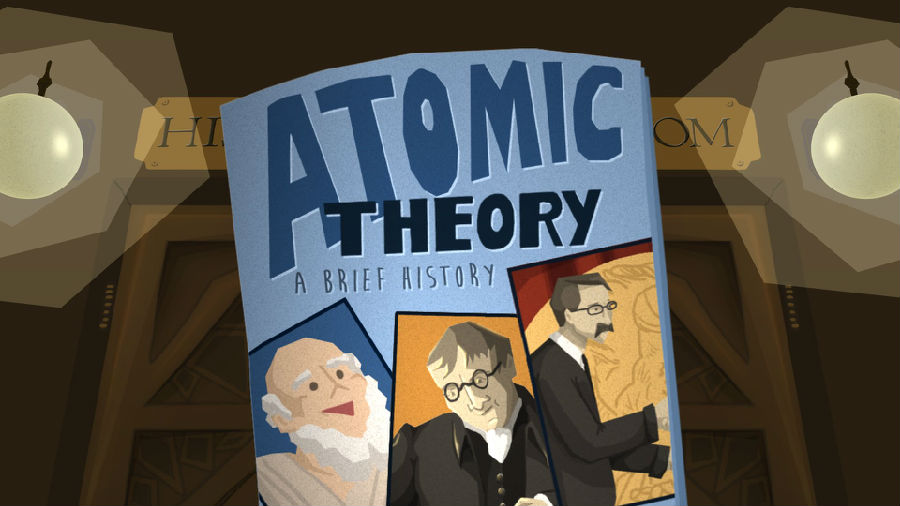(单词翻译:单击)
What do an ancient Greek philosopher and a 19th century Quaker have in common with Nobel Prize-winning scientists?
一位古希腊哲学家,一位19世纪的贵格会教徒,和诺贝尔奖获得者之间有什么联系呢?
Although they are separated over 2,400 years of history,
虽然他们相隔了2400年,
each of them contributed to answering the eternal question: what is stuff made of?
他们都为了一个永恒的问题提供了答案,那就是事物由什么组成?
It was around 440 BCE that Democritus first proposed that
在公元前440年,古希腊哲学家德谟克利特第一次提出
everything in the world was made up of tiny particles surrounded by empty space.
世上所有的物质都是由微小的颗粒组成的,而其周围是空的。
And he even speculated that they vary in size and shape depending on the substance they compose.
他猜测这些颗粒的大小和形状取决于它们所构成的物质。
He called these particles 'atomos,' Greek for indivisible.
他称这些物质为“atomos”,希腊语意为“不可分割”。
His ideas were opposed by the more popular philosophers of his day.
他的想法在当时遭到了其他更著名的哲学家们的反对。
Aristotle, for instance, disagreed completely, stating instead that matter was made of four elements:
例如,亚里士多德就完全不同意,他声称物质是由4种元素组成的:
earth, wind, water and fire, and most later scientists followed suit.
土、气、水、火,当时大多数的科学家也纷纷认同。
Atoms would remain all but forgotten until 1808,
原子学说一直被人们所忽视,直到1808年,
when a Quaker teacher named John Dalton sought to challenge Aristotelian theory.
一个名叫约翰·道尔顿的贵族教会老师开始怀疑亚里士多德的理论。
Whereas Democritus's atomism had been purely theoretical,
然而德谟克利特的原子学说仅仅是理论,
Dalton showed that common substances always broke down into the same elements in the same proportions.
道尔顿的研究显示,常见的物质总是最终能分为相同的元素,以固定的比例。
He concluded that the various compounds were combinations of atoms of different elements,
他的结论是不同的化合物是由不同原子的元素所组合,
each of a particular size and mass that could neither be created nor destroyed.
每种元素的原子都有特定的大小与质量,而且原子既不能被创造也不能被消灭。
Though he received many honors for his work, as a Quaker, Dalton lived modestly until the end of his days.
虽然他的研究得到许多赞誉,作为贵格会教徒,道尔顿一生一直保持谦虚低调。
Atomic theory was now accepted by the scientific community,
现在原子论被科学界接受了,
but the next major advancement would not come until nearly a century later
但接下来的重大进展却直至近一个世纪之后才发生:
with the physicist J.J. Thompson's 1897 discovery of the electron.
1897年物理学家J·J·汤姆逊发现了电子。
In what we might call the chocolate chip cookie model of the atom,
在我们可以称之为巧克力饼干模型原子,
he showed atoms as uniformly packed spheres of positive matter filled with negatively charged electrons.
汤姆逊的原子是负电荷的电子,均匀分布在球状正电云中。
Thompson won a Nobel Prize in 1906 for his electron discovery, but his model of the atom didn't stick around long.
汤姆逊因发现电子而荣获1906年诺贝尔物理奖,但他的原子模型没有维持很久。
This was because he happened to have some pretty smart students,
这是因为他有一些非常聪明的学生,
including a certain Ernest Rutherford, who would become known as the father of the nuclear age.
比如说欧内斯特·卢瑟福,他被称为原子核物理学之父。

While studying the effects of X-rays on gases, Rutherford decided to investigate atoms more closely
当研究X射线对气体的影响时,卢瑟福决定更进一步研究原子,
by shooting small, positively charged alpha particles at a sheet of gold foil.
他用带正电荷的α粒子轰击金箔。
Under Thompson's model, the atom's thinly dispersed positive charge would not be enough to deflect the particles in any one place.
在汤姆逊的原子模式中,原子中均匀分布的正电荷并不足以使α粒子发生偏转。
The effect would have been like a bunch of tennis balls punching through a thin paper screen.
结果应像是以一堆网球射向一张薄薄的纸屏。
But while most of the particles did pass through, some bounced right back,
然而,虽然大多数的颗粒都穿过金箔,但是一些被反弹回来,
suggesting that the foil was more like a thick net with a very large mesh.
表明所金箔片更像有大网眼的厚网,
Rutherford concluded that atoms consisted largely of empty space with just a few electrons,
卢瑟福的结论是原子中除了几个电子外,还有大量的空间,
while most of the mass was concentrated in the center, which he termed the nucleus.
大部分的质量集中在中央,他称之为原子核。
The alpha particles passed through the gaps but bounced back from the dense, positively charged nucleus.
多数α粒子由原子中空部位通过,但撞到带正电荷原子核的就被散射开。
But the atomic theory wasn't complete just yet.
至此,原子学说还并不完整。
In 1913, another of Thompson's students by the name of Niels Bohr expanded on Rutherford's nuclear model.
在1913年,汤姆逊的另一名名叫尼尔斯·玻尔的学生,扩充了卢瑟福的原子核模型。
Drawing on earlier work by Max Planck and Albert Einstein
根据早期马克斯·普朗克和阿尔伯特·爱因斯坦的研究,
he stipulated that electrons orbit the nucleus at fixed energies and distances,
玻尔提出电子围绕原子核的轨道是有固定的能量和距离(能级),
able to jump from one level to another, but not to exist in the space between.
电子可以从一个能级跳到另一个能级,但是不能存在于在两个能级之间。
Bohr's planetary model took center stage, but soon, it too encountered some complications.
玻尔的“行星模型”很快被大多数人们所接受,但是不久,这个模型遭到了一些难题。
Experiments had shown that rather than simply being discrete particles,
实验已经证明,电子并不是简单的游离微粒,
electrons simultaneously behaved like waves, not being confined to a particular point in space.
同时也会表现出波的特性,并不局限于空间中的特定位置。
And in formulating his famous uncertainty principle, Werner Heisenberg showed
维尔纳·海森堡构想了著名的“不确定性原理”,他的研究显示,
it was impossible to determine both the exact position and speed of electrons as they moved around an atom.
当电子在运动时,其精确的速度和位置是无法被判断的。
The idea that electrons cannot be pinpointed but exist within a range of possible locations
电子无法被准确定位,但是可以确定其可能位置范围,
gave rise to the current quantum model of the atom,
这个理论启发了现在的“量子原子模型”,
a fascinating theory with a whole new set of complexities whose implications have yet to be fully grasped.
这是一个让人产生无限遐想的理论,也更加复杂,这个理论至今还尚未被完全掌握。
Even though our understanding of atoms keeps changing, the basic fact of atoms remains,
尽管我们对原子的理解不停的在改变,但是基本的事实没变,
so let's celebrate the triumph of atomic theory with some fireworks.
现在我们用烟火来庆祝一下原子理论的巨大成功。
As electrons circling an atom shift between energy levels,
当电子围绕着原子核改变能级的时候,
they absorb or release energy in the form of specific wavelengths of light, resulting in all the marvelous colors we see.
它们通过发出一些特殊的光线获取或丢失能量,这就产生了我们所看到不同的颜色。
And we can imagine Democritus watching from somewhere, satisfied that over two millennia later,
我们可以想象德谟克利特如果看到两千年后的原子学说会是多么满意,
he turned out to have been right all along.
他的学说一直都是正确的。


